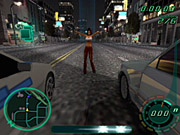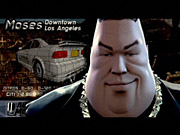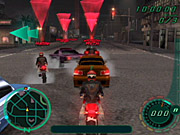As the PlayStation 2 driving-game market becomes more and more cluttered, we're starting to see a lot of franchises try to move their forms of racing in different directions. On the simulation side, Gran Turismo remains the obvious choice. For pure high-speed arcade thrills, Acclaim's Burnout 2 does the job. Rockstar's latest driving game, Midnight Club II, reaffirms the series' position as a solid open-city racing game while introducing online play and some new driving techniques in hopes of mixing things up a bit. However, some of these new features don't pan out quite as well as they could have.

Thankfully, the rest of the game's modes are a little quieter, though you can only access cars, races, and cities that you've opened up in the career mode. Arcade mode lets you cruise aimlessly, race a number of laps on a variety of predetermined circuits, replay any of the checkpoint races you've completed in the career mode, and enter two-player battle mode races, which let you play in either a standard sort of capture the flag game or a bomb-oriented variant called detonate, where players race to pick up a detonator and drive it to a scoring spot on the map to earn points. The game also has a race editor mode that allows you to place your own checkpoints and configure your own races. These custom races can then be saved and taken online. This is a nice addition, but it would have been nicer if you had been able to truly place your checkpoints anywhere on the map. Instead, you're limited to specific points on the map.
The game's broadband-only online mode contains a good number of options, yet it's surprisingly sparse in some spots. Just about anything you can do in the game's arcade mode is available here, though instead of being limited to playing against just the game's AI or a second player, you can play against a total of seven other human opponents. The increased number of cars definitely makes modes like capture the flag and detonate much more meaningful. The game also has a number of power-ups that come into play here, such as the ability to inflict reverse steering, slippery handling, and other nasty effects on your opponents. While the online play is just as smooth as its offline counterpart, the front-end options that tie it all together are a little lacking. Considering the fiercely competitive nature of the underground street racing world, a rankings system would have really added a lot of incentive to the game's online mode, as would some sort of wagering system to help up the stakes in certain races. Also, hosts seem to be unable to start games before all the joined players have synched up, though the game doesn't actually tell you who's synched up and who isn't. Instead it just says that the game isn't ready to begin. When you're playing with a group of players who have solid connections, you'll never see this, but when a flaky player joins up, the host may be unable to begin the game without first booting that player.

The open-ended nature of Midnight Club II can be both a blessing and a curse. On one hand, it's impressive to have such a large chunk of road available to you at any given time, and the checkpoints are always set up in such a way that there are always at least two or three viable paths through a course. However, this open-ended design also means that you'll usually be going through each race several times just to figure out where you're supposed to go. More often than not, you'll find yourself staring at the radar in the corner of the screen instead of focusing on the actual driving, plotting your course on the fly, and watching the radar arrows of the AI drivers to discover alternate routes that you may not be hip to. The game also gives you a Crazy Taxi-like arrow that just points in the direction of the next checkpoint, but given the game's winding and numerous paths to victory, this arrow is totally useless. The game also makes use of rubber-band AI to keep races close, so you'll definitely notice that the AI racers are always on your tail when you're doing well and they'll rarely pull so far ahead that they become untouchable, provided you're taking a viable route to the finish line.

Midnight Club II looks impressive for the most part. The cities are nice and large, with some pretty good texture quality and variety. The car models look OK, though licensed cars would have been a plus. Also, the cars get a little too shiny. The game runs at a pretty smooth frame rate, makes good use of particle effects, and does a decent job of conveying a sense of speed, though the blur effect used for slipstream turbo boosts is a little distracting. Since the game takes place primarily at night, headlights come into play quite often. Unfortunately, the headlight effects are pretty weak. The outer edges of your headlights' coverage don't drop off gradually--instead, the lighting intensity is broken up into a series of bands that get dimmer and dimmer. In most cases this wouldn't even be an issue, but since the entire game is set at night, it's very noticeable, especially in darker sections of the city. Other than that, Midnight Club II pulls off its gritty look very well.
The sound used throughout Midnight Club II is pretty standard. The engine noises, the sound of your tires on different surfaces, and the whooshing explosion of a nitrous boost are all present. Considering how well the soundtrack of Rockstar's last major release--Grand Theft Auto: Vice City--complemented the action, Midnight Club II's music is a bit of a letdown. The music is more targeted at fitting the style of the cities than the racing action itself, and it rarely meshes well with the game's high-adrenaline style and gameplay.

Midnight Club II is just as solid as the original Midnight Club was in its day, and it features a handful of improvements. But the original game came out during the fairly sterile launch period for the PlayStation 2 and had very little competition. Now, with driving and racing games coming out in a fast and furious fashion, Midnight Club II has a lot to live up to. It performs well, but there are definitely more-interesting PlayStation 2 driving games on the market.